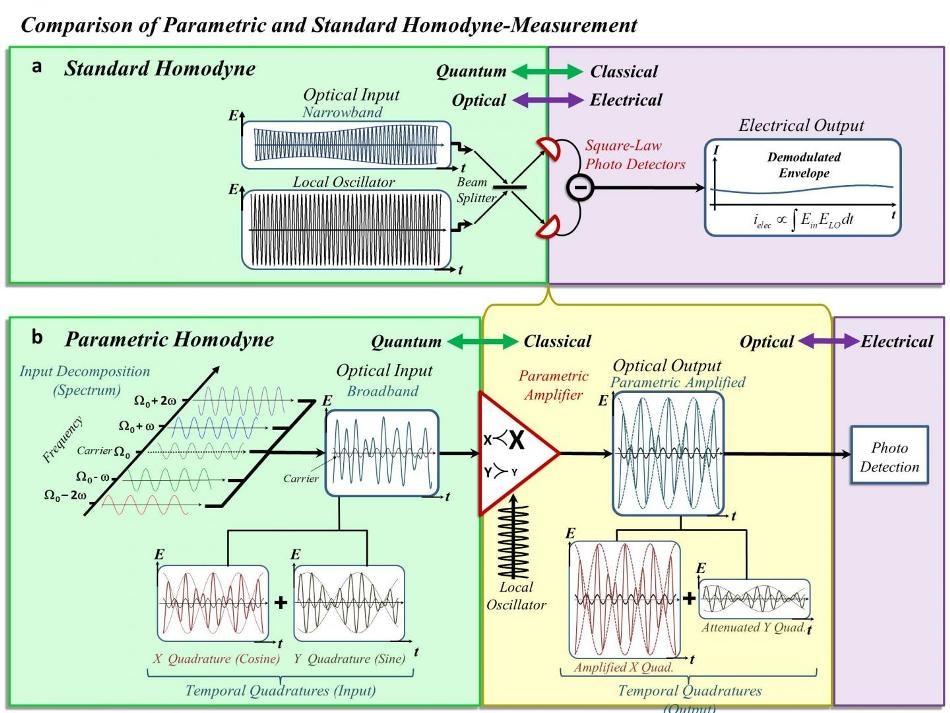Feb 16 2018
Quantum communication, which assures total data security, is one of the most progressive divisions of the “second quantum revolution.” In the field of quantum communication, the parties that take part can identify any attempt at intruding by making use of the basic principle of quantum mechanics that a measurement has an impact on the measured quantity. Hence, the mere presence of an intruder can be identified by recognizing the traces left behind by his evaluations of the communication channel.
 This image illustrates the researcher's technique, in which they replaced electrical nonlinearity with a direct optical nonlinearity, transforming the quantum information into a classical optical signal. (Image credit: Bar-Ilan University)
This image illustrates the researcher's technique, in which they replaced electrical nonlinearity with a direct optical nonlinearity, transforming the quantum information into a classical optical signal. (Image credit: Bar-Ilan University)
At present, the main disadvantage of quantum communication is the gradual speed of the transfer of data, which is restricted by the speed at which the parties can carry out quantum evaluations.
Scientists from Bar-Ilan University have developed a technique that outclasses this “speed limit,” and allows an increase in the data transfer rate by over five orders of magnitude. The outcomes of the study have been published in the Nature Communications journal on February 9, 2018.
Homodyne detection is a central component of quantum optics, functioning as a basic tool for processing quantum information. The standard homodyne technique is hampered by a high bandwidth restriction. Although quantum optical phenomena, adopted for quantum communication, can easily span a bandwidth of several teraHertz, the standard techniques for processing this information are intrinsically restricted to the electronically accessible megaHertz-to-gigaHertz range. This generates a drastic gap between the applicable optical phenomena used for conveying the quantum information, as well as the potential to evaluate it. Therefore, the processing rate of the quantum information can be highly restricted.
As part of their study, the scientists substitute the electrical nonlinearity that functions as the focal point of homodyne detection, which converts the optical quantum information into a classical electrical signal, with a direct optical nonlinearity, converting the quantum information into a classical optical signal. Consequently, the output signal of the evaluation continues to be in the optical regime and conserves the expansive bandwidth offered by the optical phenomena.
We offer a direct optical measurement that conserves the information bandwidth, instead of an electrical measurement that compromises the bandwidth of the quantum optical information.
Dr. Yaakov Shaked
To demonstrate this concept, the scientists carried out a concurrent evaluation of an ultra-broadband quantum optical state, extending over 55 THz, exhibiting non-classical behavior over the complete spectrum. Such an evaluation by adopting standard technique would be practically improbable.
The work was achieved using a partnership between the Quantum Optics Labs of Professor Avi Pe’er and Professor Michael Rosenbluh, in cooperation with Yoad Michael, Dr. Rafi Z. Vered, and Leon Bello from the Department of Physics and Institute for Nanotechnology and Advanced Materials at Bar-Ilan University.
This innovative type of quantum evaluation holds good also to other divisions of the “second quantum revolution,” for example, super-sensitivity quantum sensing, quantum computing with superpowers, and high-resolution quantum imaging.